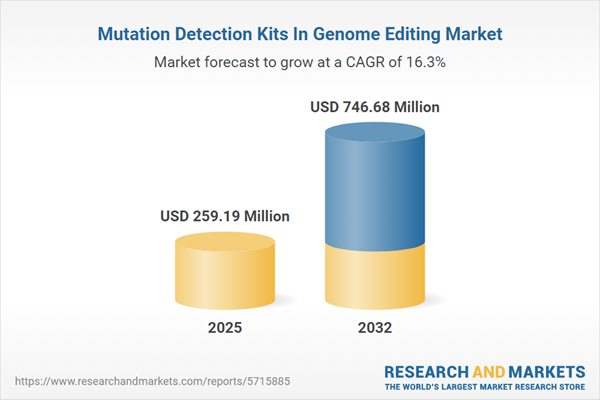Speak directly to the analyst to clarify any post sales queries you may have.
The Mutation Detection Kits in Genome Editing Market is advancing rapidly, driven by the increasing need for reliable validation tools in genetic modification workflows. As genome editing becomes more central to precision biology, robust mutation detection solutions are transforming research and clinical applications.
Market Snapshot: Mutation Detection Kits in Genome Editing
The Mutation Detection Kits in Genome Editing Market grew from USD 222.74 million in 2024 to USD 259.19 million in 2025. It is expected to continue growing at a CAGR of 16.32%, reaching USD 746.68 million by 2032. This expansion reflects sustained demand for quality assurance in genome editing, with continuous innovation in molecular techniques and adoption across both established and emerging biotechnology hubs.
Scope & Segmentation
This report delivers comprehensive insight across the full scope of the market, structured by core technologies, detection approaches, applications, end users, workflows, and distribution channels, as well as across major global regions:
- Technology
- CRISPR (Cas9, Cas12, Cas13)
- Meganuclease
- TALEN
- Zinc Finger Nuclease
- Detection Method
- High Resolution Melt Analysis
- NGS (amplicon, targeted, whole genome sequencing)
- PCR (digital, end-point, real time)
- Restriction Fragment Length Polymorphism
- Sanger Sequencing
- Application
- Agricultural Biotechnology
- Basic Research
- Clinical Diagnostics
- Drug Discovery
- Personalized Medicine
- End User
- Academic and Research Institutes
- Clinical Diagnostic Laboratories
- Contract Research Organizations
- Pharmaceutical and Biotechnology Companies
- Distribution Channel
- Direct Sale
- Distributor
- Online Distribution
- Original Equipment Manufacturer
- Workflow Stage
- Data Analysis
- Post Editing Validation
- Pre Editing Quality Control
- Regions Covered
- Americas: United States, Canada, Mexico, Brazil, Argentina, Chile, Colombia, Peru
- Europe, Middle East & Africa: United Kingdom, Germany, France, Russia, Italy, Spain, Netherlands, Sweden, Poland, Switzerland, UAE, Saudi Arabia, Qatar, Turkey, Israel, South Africa, Nigeria, Egypt, Kenya
- Asia-Pacific: China, India, Japan, Australia, South Korea, Indonesia, Thailand, Malaysia, Singapore, Taiwan
Key Takeaways
- Mutation detection kits are essential for confirming genome editing accuracy and minimizing risks from unintended genetic changes.
- Technological diversity, including CRISPR innovations and high-throughput sequencing, is reshaping detection workflows for greater reliability and scale.
- End-to-end solutions now integrate quality control, post-edit validation, and data analytics, allowing for streamlined, informed decision-making and operational efficiency.
- Cross-platform compatibility and standardized benchmarks are increasingly prioritized, enhancing reproducibility and regulatory compliance.
- Market growth is supported by expanding adoption in agricultural biotechnology, clinical diagnostics, and pharmaceutical research, with tailored approaches for each application area.
- Strong regional activity, from government investments in Asia-Pacific to collaborative research frameworks in Europe, is accelerating global uptake and innovation.
Tariff Impact on Supply Chains
Recent United States tariff changes have introduced new complexity, affecting sourcing, manufacturing, and delivery schedules for mutation detection kits and key laboratory consumables. Manufacturers are adapting with diversified procurement strategies, while industry and regulatory collaboration seeks to mitigate costs and secure critical reagent access. These actions are driving supply chain resilience and operational agility across the sector.
Research Methodology & Data Sources
This report leverages primary interviews with key market participants and end users, comprehensive analysis of peer-reviewed literature, technical protocols, and structured interrogation of company filings. Proprietary data models support quantitative validation, with rigorous triangulation and review by subject experts ensuring insight reliability.
Why This Report Matters
- Delivers actionable intelligence for senior leaders to assess technology investments, commercial pathways, and resilience measures.
- Supports strategic planning by highlighting evolving trends in market segments, regulatory dynamics, and supply chain adaptations.
- Enables organizations to optimize their position with insight into leading players, fast-growing regional markets, and the impact of emerging genome editing technologies.
Conclusion
The Mutation Detection Kits in Genome Editing Market is undergoing transformation, with innovative workflows, evolving technologies, and strategic collaboration shaping its future. Stakeholders who anticipate supply chain shifts, regulatory changes, and technical demands will maintain advantage as the market continues to expand.
Additional Product Information:
- Purchase of this report includes 1 year online access with quarterly updates.
- This report can be updated on request. Please contact our Customer Experience team using the Ask a Question widget on our website.
Table of Contents
3. Executive Summary
4. Market Overview
7. Cumulative Impact of Artificial Intelligence 2025
Companies Mentioned
The companies profiled in this Mutation Detection Kits in Genome Editing market report include:- Thermo Fisher Scientific Inc.
- Illumina, Inc.
- QIAGEN N.V.
- Agilent Technologies, Inc.
- F. Hoffmann-La Roche Ltd
- Promega Corporation
- New England Biolabs, Inc.
- Bio-Rad Laboratories, Inc.
- Merck KGaA
- Takara Bio Inc.
Table Information
| Report Attribute | Details |
|---|---|
| No. of Pages | 186 |
| Published | October 2025 |
| Forecast Period | 2025 - 2032 |
| Estimated Market Value ( USD | $ 259.19 Million |
| Forecasted Market Value ( USD | $ 746.68 Million |
| Compound Annual Growth Rate | 16.3% |
| Regions Covered | Global |
| No. of Companies Mentioned | 11 |









